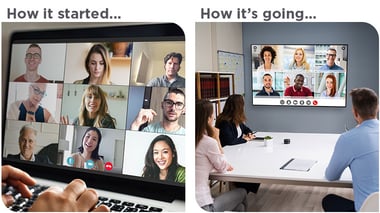Four strategies to help foster more collaboration in a hybrid work world
There’s no question about it – workplaces around the world continue to evolve because of the pandemic. How will your colleagues and teams collaborate when they’re scattered across many locations? What might happen to productivity if technology fails to do what it should do? Does existing technology meet the new demands of a hybrid workforce?
The challenges standing before most IT teams are similar in many ways. Here are four challenges your organization can overcome with the right planning.
Challenge #1: Employee work experience needs have changed (at home and in the office)
The majority of enterprise employees have been working independently from a remote setting for the last 18 months. During this time, they taught themselves how to maintain relationships and keep tasks moving forward.
As offices open and employees are invited back to the workplace, some will happily return so they can spend time with colleagues, collaborate and have a more consistent work routine. Others will choose to stay home, only coming to the office when it’s necessary. The challenge is connecting these hybrid workers with technology.
Meet the challenge:
Today, enterprise organizations must focus their efforts on the tools and systems designed to help the workforce connect, collaborate, and solve problems in a more meaningful way. Hybrid work groups are here to stay – and regardless of where employees work, they need to feel empowered (with sound technology systems) to get work done.
Challenge #2: Yesterday’s technology no longer meets employees’ needs
 As recently as two years ago, remote participation in meetings was limited. When people did join a meeting remotely, they were voice-only, or their image appeared on a small corner of a monitor mounted on the far side of the room. In either case, it was hard for them to participate and easy to forget they were there.
As recently as two years ago, remote participation in meetings was limited. When people did join a meeting remotely, they were voice-only, or their image appeared on a small corner of a monitor mounted on the far side of the room. In either case, it was hard for them to participate and easy to forget they were there.
Now, after primarily using Microsoft Teams, Zoom and other unified collaboration solutions, employees are used to a different remote experience. They’ve grown to appreciate center-facing cameras, visual and audio equality among participants and the ability to make eye contact with one another. They’ve also grown to rely on visual alignment cues (or lack thereof) when presenting ideas or telling stories.

Meet the challenge:
Organizations must strive to create equity among participants. This goal should become the focus of collaboration space updates or redesigns. Shift your meeting technology objective away from video conferencing and toward visual collaboration.
Challenge #3: Shiny new tools don’t always solve business problems
It’s always been tempting to look at the newest, coolest technology solutions and think backward from there about how those solutions could enhance your business. We get it – we love technology, too. But companies are discovering that a solution-driven approach doesn’t always address the core challenges they face.
Meet the challenge:
Instead of focusing on the technology, first look at the human experience – then identify what technology solutions enhance that experience. You’ll find this a very different mindset from the traditional, “here’s some cool new technology now let’s figure out how to leverage it,” way of thinking.
Challenge #4: Audio-visual solutions aren’t part of IT standardization
As more enterprises turn to IT standardization, many find that audio-visual solutions aren’t integrated into that approach. The Enterprise Solutions group at AVI Systems grew out of the recognition that there wasn’t an existing methodology – or an ITIL practice – for AV strategy.
Meet the challenge:
Using ITIL as our foundation, we created a rigorous process that guides how we develop and design Enterprise AV systems. With this process, we’re able to measure success along the way. The goal? Move beyond traditional integrators to support each enterprise-level need to have AV standards that are IT centric.
Why enterprise leaders turn to AVI Systems
The pandemic created an opportunity for businesses and their vendor partners to reflect on every aspect of how they operate. Through our work with nearly every Fortune 1,000 company in North America, we’ve gained detailed insight into the drivers of innovation that businesses need now more than ever to ensure employees can collaborate and remain productive.
If you’re ready to take a strategic approach that maximizes your business outcomes, we welcome the opportunity to walk you through our approach.
Contact us today.








